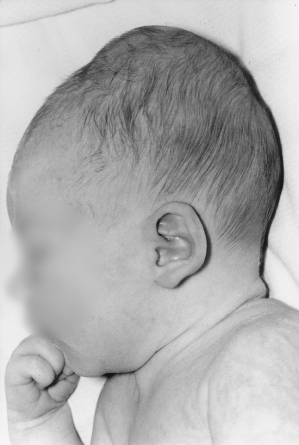- Risk factors for birth injury
- Injuries to the scalp, skull and brain
- Bone and joint injuries
- Peripheral nerve injuries
- Soft tissue injuries
- Organ injuries
- Injuries sustained in the neonatal intensive care unit
Introduction
Despite skilled obstetric care, injuries may be sustained either during labour or during delivery. Injuries can also occur as a result of inappropriate use of excessive force. Sometimes bony injury may be an unintended consequence of saving the baby’s life when there is severe shoulder dystocia. Preterm babies are particularly susceptible to injury, either at delivery or after admission to the neonatal intensive care unit (NICU) where they are vulnerable to preventable iatrogenic injuries.
The decreased incidence in birth trauma over recent years has been attributed to changing trends in obstetric management, such as caesarean section instead of difficult vaginal delivery. Despite the falling incidence, birth injury is still a cause for concern to the obstetrician and neonatologist. Parents sometimes attribute birth injury to obstetric mismanagement, and this may result in litigation. Unfortunately, such events encourage the practice of defensive obstetrics, and a high caesarean section rate may be a consequence of this. There is evidence that the presence of senior experienced obstetricians on the delivery suite can reduce the caesarean section rate.
Where iatrogenic or preventable injury has occurred it is best to be honest and explain the nature of the circumstances of the injury carefully to parents. However, injury, especially brain injury, can occur even after normal labour and delivery and mismanagement should not be implied without evidence.
Table 7.1 lists the major causes of birth injury and their incidence.
Table 7.1 The commoner types of birth injury and their incidence
| Cephalhaematoma | 1:100 |
| Brachial plexus injury | 0.5–1:1000 |
| Facial nerve palsy | 1:500 |
| Bony (non-skull) fracture | 1:1000 |
| Skull fractures | Rare |
| Subaponeurotic haemorrhage | 1:1250 |
| Major subdural haemorrhage | 1:50 000 |
| Spinal cord injuries | Very rare |
| Overall incidence | 7:1000 births |
Risk Factors for Birth Injury
The effect of changing patterns of obstetric practice on birth-associated mechanical injuries is difficult to evaluate. However, a number of risk factors for birth injury have been identified, especially vaginal breech delivery (Tables 7.2 and 7.3).
Table 7.2 Risk factors for birth injury
| Fetal condition | Prematurity |
| Small for gestational age | |
| Multiple pregnancy | |
| Fetal distress | |
| Malpresentation | Breech presentation (see Table 7.3) |
| Brow, face, compound presentation | |
| Malposition | Unengaged head |
| Occipitoposterior arrest | |
| Deep transverse arrest | |
| Cephalopelvic disproportion | Macrosomia, e.g. infant of diabetic mother, hydrops fetalis |
| Macrocephaly | |
| Previous pelvic fracture | |
| Shoulder dystocia | |
| Prolonged labour | Delay–cervix not fully dilated |
| Delay–cervix fully dilated | |
| Precipitate labour | |
| Maternal factors | Nulliparity |
| Short stature | |
| Obesity | |
| Inexperienced obstetrician or midwife |
Table 7.3 Injuries more likely to occur in infants delivered by breech
| Haemorrhage | Subdural tears due to tentorial rupture |
| Rupture of intra-abdominal viscus (usually liver or kidney) | |
| Occipital osteodiastasis with cerebellar haemorrhage | |
| Orthopaedic | Dislocation: shoulder, cervical vertebrae, hip, knee |
| Fracture: clavicle, humerus, femur | |
| Damage to sternomastoid muscle | |
| Neurological | Asphyxia secondary to cord prolapse |
| Cervical brachial plexus injury: Erb’s or Klumpke’s paralysis | |
| Facial nerve palsy | |
| Soft tissue injury | Extensive bruising, particularly genitals |
Injuries to the Scalp, Skull and Brain
Caput Succedaneum
This is benign swelling of the subcutaneous tissue of the scalp from prolonged delivery or ventouse cup. It usually resolves within a few days, occasionally with bruising.
Erythema, Abrasions and Lacerations
Erythema and abrasions may be seen following forceps and vacuum delivery and with cephalopelvic disproportion. Lacerations to the scalp or face can occur during episiotomy, uterine incision at caesarean section, and scalp electrode monitoring (Fig. 7.1).
Cephalhaematoma
This occurs in about 1% of newborn infants and is due to bleeding between the periosteum and the cranial bones (usually parietal, less commonly occipital) as a result of shearing or tearing of communicating veins during delivery. The extent of the swelling is limited by the underlying skull bone and does not cross suture lines (see Fig. 7.2). It is due to buffeting of the fetal skull against the maternal pelvis, which is seen especially in prolonged labour. It may also occur following a forceps or vacuum delivery. Subperiosteal bleeding is slow and may not appear until the second day of life. Enlargement may occur during the first week and the swelling may persist for several weeks.
Box 7.1 lists complications associated with a cephalhaematoma.
Stay updated, free articles. Join our Telegram channel

Full access? Get Clinical Tree




